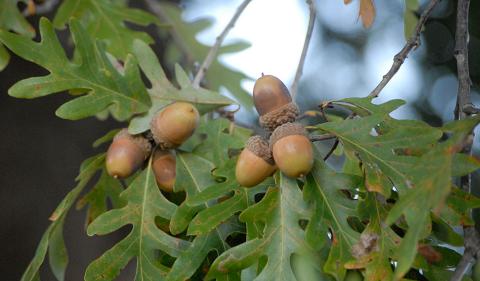Jayar Kindsvogel, of Center, North Dakota, was in the U.S. Air Force and was stationed in Alaska for eight years. Because of his passion for hunting, he spent most of his free time in the Last Frontier hunting or guiding hunts. Kindsvogel often hunted on the tundra and in the woods where he wore Mossy Oak Bottomland and still does today.
My First Caribou Hunt
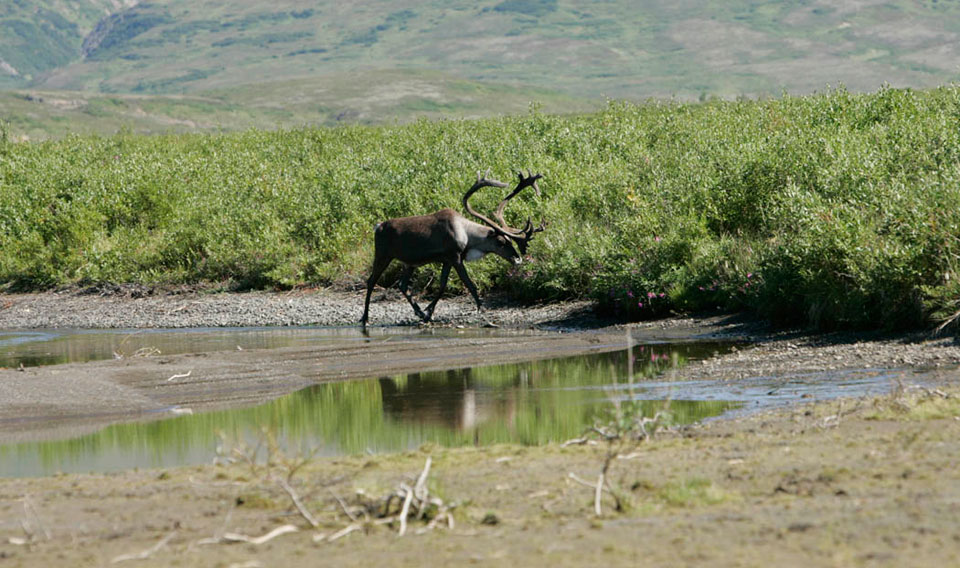
While I lived in Alaska, a friend and I drove 850 miles one way from Anchorage, Alaska, to Deadhorse, which is as far as you can go north on the Haul Road also known as Dalton Highway. The road ends at the Gulf of Alaska where the two towns of Deadhorse and Prudhoe Bay sit side by side. We were hunting in an archery-only area and planned to hunt for 10 days. We finally located a herd of caribou that was migrating close to the road.
On the tundra where we were hunting, there were several pull-off spots for our truck. But no one is allowed to drive on the tundra with trucks or ATVs. So, one advantage of going on an archery-only hunt is that all you have to do to take a shot at a caribou is step out of your truck and step off the road to shoot. If you hunt with a rifle, you must walk five miles away from the nearest road before hunting. So, we hunted around the Alaskan Pipeline, because the caribou would go under the pipeline. These caribou were well-educated. They realized that when they got close to the pipeline, they needed to run as quickly as they could. From the research I’d done, I learned that caribou could run as fast as 30 mph and walk at about 6 mph.
The tundra is very bumpy and not easy for walking. So, if a hunter tries to take off running to get in front of the caribou, more than likely he won’t catch up to the bull he wants to take. On the fourth day of our hunt, we spotted a caribou about 20 yards off the road. We’d learned that if you kept your vehicle moving, the caribou wouldn’t spook. However, if you stopped your vehicle, the caribou would run like the wind. I got out on the driver’s side of the vehicle and walked beside the truck while my friend drove the truck slowly. The truck hid my movement.
Once the truck was right beside the caribou, I stepped over into a ditch on the opposite side of the road from the caribou, ranged the caribou and learned he was standing at 37 yards. I nocked an arrow quickly, came up, aimed and shot. I actually thought at first that I’d missed the caribou because I saw my arrow skip off a rock behind the caribou.
The caribou took off like a rocket, ran across the road and went down into the ditch on the other side of the road from where I was. I quickly ran and got into the same ditch where the caribou was and whistled, after nocking an arrow. I knew that caribou were much like mule deer in that they’d stop when they heard a sound they couldn’t identify. Once the caribou stopped, he turned broadside to me, I quickly ranged him at 61 yards, and I took the shot. I watched as my arrow hit the caribou in almost the same spot where I’d shot my first arrow. The caribou ran about 90 yards from the road, and that’s when the fun ended and the work began.
When I reached the caribou, I saw that the two entry holes my arrows had made were only one inch apart. My friend and I decided to drag the caribou to the road thinking that 90 yards wouldn’t be very far to drag an animal. After pulling on the caribou for a while, we realized that the caribou was bigger and heavier than we had thought. We field-dressed my caribou and started dragging him again. Due to his antlers being in the velvet, we opted not to drag him by his antlers. We each grabbed a leg of the caribou, however, he was still too heavy for us to drag. We skinned him out, so I could keep the hide, quartered him and put the meat on the tarp. Then we thought we could drag the tarp with the meat on it over to our truck, put the meat in game bags and hang those in the back of the truck.
We were six miles south of town. This hunt was at the end of June, and the temperature was somewhat warm. The mosquitos started swarming. The only part of my body that was exposed was from my elbows down to my hands. Once we finished field dressing the caribou, my arms looked as though I had chicken pox. The mosquitos there were like pterodactyls and were so big you might even be afraid that they could carry you off.
That night when we arrived at camp, we prepared caribou tenderloins for supper. The temperature was cool enough to keep the meat chilled. The next morning we got up and took the meat to the airport at Prudhoe Bay. I only had to pay $50 to have the meat stored and flown back to my home in Anchorage. We also froze the caribou’s rack, because it was in the velvet, and I wanted to preserve it for my mount. The caribou I took was old, he had a gray face, and he didn’t have many points. I had the horns mounted from this great hunt.
Almost Moose in Alaska
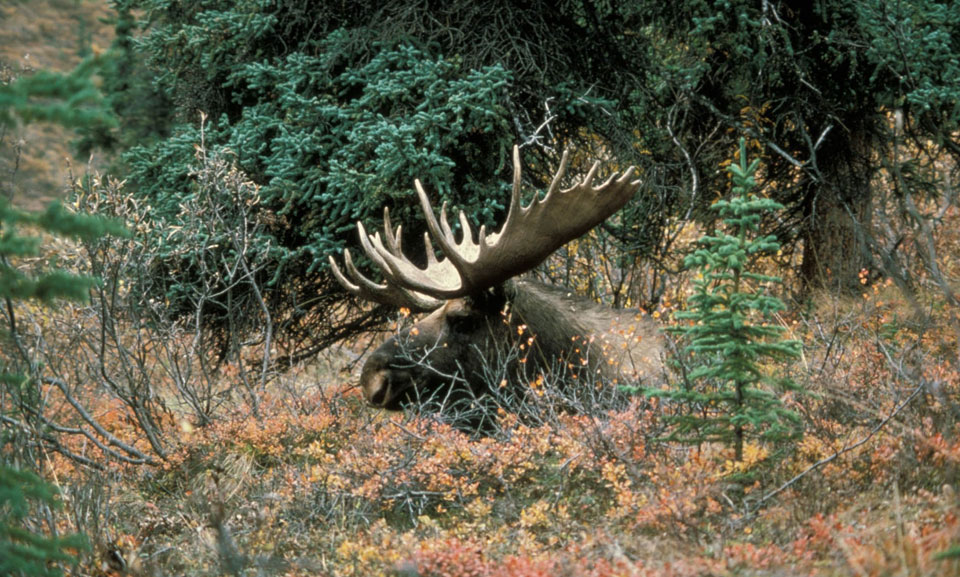
When I lived in Alaska, Jimmy, a friend of mine, and I took off 10 days at the beginning of October one year to go moose hunting. We went to Healy, Alaska, an archery-only area. We set up our camp, went to the top of a hill, glassed for moose and saw a couple of cow moose. On the second morning, when we woke up, we saw that four inches of snow had fallen overnight. The temperatures were in the high 30s. When we headed out to go back to the top of the hill, we shot some ptarmigans with our bows, cleaned them and left them sitting on our four wheeler. Then we hiked in to the ridge where we wanted to glass for moose. We didn’t see any moose that day.
Just before dark, we hiked back to our four wheeler and realized that the ptarmigans we’d planned to eat for supper were gone. Looking at the ground, we saw fox tracks leading up to the four wheeler where our birds had been. On the way back to camp, we shot a few more ptarmigans and ate them for supper.
The fifth morning of the hunt when we woke up and got ready to leave camp, we spotted grizzly bear tracks that circled our camp. The tracks started about 80 yards from our tent and went all the way around the tent in a circle. Every morning after that, the path the grizzly had taken was deeper and deeper. So, we knew he was circling our camp every night when we went to sleep.
The last day we were in camp we discovered why the grizzly was coming in every night. There was a dead moose about 150 yards from our camp that apparently the bear had killed. We feel that the bear was circling our camp every night to let us know he was there, and he was protecting his kill.
On this day, we were on a high point, overlooking three fingers of woods that came out into a valley. We spotted some cows and small bulls that weren’t legal. In the region where we were hunting, the bull’s rack had to be 50 inches or wider, or he had to have three brow tines or more on one side of his rack for us to take him.
As we prepared to leave where we were and go sit on a different ridge, the sun hit the ridgeline across the valley from us. I said to Jimmy, “There’s a moose, and he’s really big. Grab the boat paddle.”
We’d put electrical tape all around the edge of the boat paddle we had with us. Then when we scraped the trees, it sounded more like a moose raking the trees. Jimmy grabbed the boat paddle and went behind me, going to war with a willow tree with the boat paddle. Through my binoculars, I watched as the moose picked up his head and looked straight at us. Then he started down the mountain and came across the valley at a trot toward us. I moved down the hill where we’d been sitting, climbed through some willows and took stock of what I had. I had my bow and my arrows, but I didn’t have my bear spray and my pistol. In Alaska, you could carry a pistol to defend yourself against bears. I realized I’d gotten so excited that I’d left those items in my pack where we’d been scouting. I was praying I wouldn’t see a bear.
I got into position around some brush, and the moose came in downwind of me in the valley. The wind was blowing 45 mph, and he laid down in the muck in the bottom of the valley where the grass was about six feet tall. The moose began rolling around on his back like a horse would and was tearing up the area. He probably thought that Jimmy and his boat paddle was another bull moose coming into where he was.
The moose was about 150 yards when he turned, walked directly toward me and stopped at 45 yards. With a 45-mph crosswind, I knew this shot would be difficult. I waited, and the moose came from the upwind side of me, walking stiff-legged and swinging his head back and forth, like he was ready to fight. Then he turned, walked toward me once more and laid down. He had his back to me and didn’t present any type of shot. I put my bow on my back and crawled toward the moose. The wind’s blowing so hard kept the moose from hearing me.
When I was 23 yards from the moose, I came up behind a pine tree with some brush behind me. I was in the perfect position to take the shot once the moose stood up. I remained tucked-up behind the pine tree for 2-1/2 hours, waiting for the moose to stand up. As soon as he stood up, he was broadside to me, but then he took one step behind some brush that blocked my shot at his vitals. He looked back and forth and especially looked hard toward Jimmy who was about 70 yards above me. Then the moose saw a cow moose on the other side of the valley and quickly turned with his butt facing me, and not presenting a shot, while walking to the cow. Although Jimmy was calling and raking the trees, he never could get the moose to look at him because the moose had spotted that cow. We hunted the next four days and never saw that bull or any other bull moose.
Jimmy is a photographer, and he was photographing the moose when he stood up. I took one of the pictures that Jimmy had made of the moose broadside with his head turned toward Jimmy and showed it to a moose guide. The moose guide said, “That bull’s rack was well over 60-inches wide, and he had four brow tines on each side of his rack. He was a legal bull for sure.”
Once the bull came to within 27 yards, I spotted blood coming out of his hip. Evidently this moose had been in a fight and gored by another moose. We even tried to blood trail this moose, but we never could find the bull. This bull moose was the biggest I’d ever seen. Although I didn’t take him, I had a great hunt.
North Dakota Mule Deer
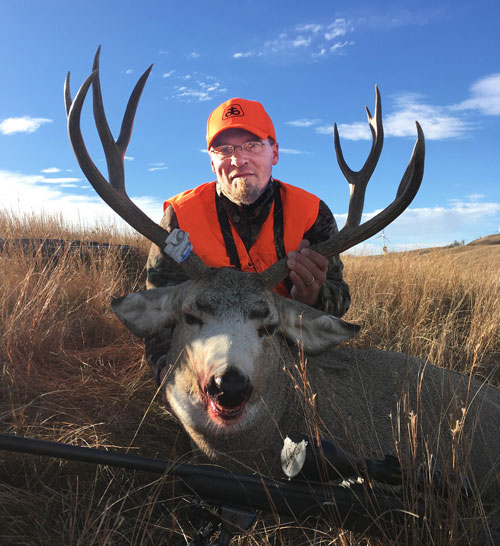 After living in Alaska for eight years, I lived in Las Vegas, Nevada, for a while before moving to North Dakota where I took a really nice mule deer with my rifle. I was hunting only six miles north of where I lived in Center. A friend of mine offered to take me hunting in some big, open country and promised, “We’ll get you a deer.”
After living in Alaska for eight years, I lived in Las Vegas, Nevada, for a while before moving to North Dakota where I took a really nice mule deer with my rifle. I was hunting only six miles north of where I lived in Center. A friend of mine offered to take me hunting in some big, open country and promised, “We’ll get you a deer.”
I sat on one point looking at a big pasture, and my friend sat on another point not far from me. My friend whistled and then started waving for me to come to where he was glassing. He’d spotted two, nice mule deer at about 1,000 yards away. But there was a bigger buck that continued to come to where the two smaller bucks were and started running the smaller bucks away from the does. We watched these three bucks for about a half hour. The second biggest buck went and laid down on the end of a point that was surrounded by a big valley. I told my friend, “I think I can get on that mule deer.”
He answered, “Okay, you go after him, and I’ll sit on this hill where you can see me. I’ll give you hand signals to direct you in to where the buck is bedded down.” I put my pack on my back, picked up my rifle and decided to take the long way around to reach that buck by staying off the ridgeline where he might spot me.
A power pole on the ridgeline was close to where the buck was bedded. As I made the stalk, I had a very good point of reference to know where the buck was. Once I got closer to where the buck was bedded, I belly crawled up the mountain. When I reached the crest of the hill, I opened my bipod out on the end of my rifle. I could see the buck still laying down on the end of the point. I ranged him, and he was 326 yards from me. I thought to myself, “I can make that shot.” However, I decided I’d wait for the buck to stand up to have a bigger target.
The buck was facing me. As I studied the position of the muley, I could see his vital area. I finally decided to take the shot. My buddy who was spotting the buck for me kept throwing his hands up in the air as if to say, “Shoot him. Shoot him.” I put my scope at the top of the muley’s back because my scope didn’t have mil-dots for different yardages. I’d shot that rifle enough to know how much holdover I needed at that range to effect a lethal hit. Slowly I squeezed the trigger. When the rifle reported, the buck jumped up and then hunched up. I didn’t see him after that.
After the shot, I waited awhile. I saw the smaller buck come out of a valley with a group of does. However, I didn’t see the buck I’d shot or the bigger buck. But my buddy had a deer tag, so I hoped that maybe the bigger buck had run by him. Finally my buddy and his son came over. We went over the ridge and found my mule deer buck scoring 150 Boone & Crockett points not 30 yards from where I’d taken the shot. I’d made a good double-lunged shot.
We’re excited that my buddy’s son gets his youth license this deer season. His first tag for youth season, which is for 12-13 year olds, is a doe tag. We’ve built a blind for him that’s about 85 yards for the longest shot he’ll have to take. But more than likely, we expect a doe to come in about 40-50 yards from the blind.
Whitetail Deer in North Dakota
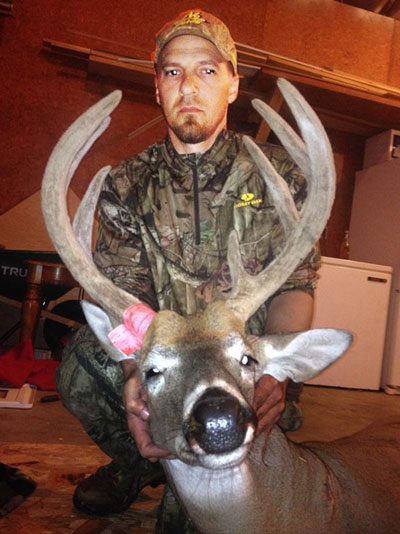 Four years ago, I found some public land just a little north of my home in Center. A corn field was down in the valley that had several ridges funneling into it. I started watching this corn field about two to three months before hunting season opened. I saw numbers of mule deer and whitetails that were mostly spikes and forked-horn bucks there.
Four years ago, I found some public land just a little north of my home in Center. A corn field was down in the valley that had several ridges funneling into it. I started watching this corn field about two to three months before hunting season opened. I saw numbers of mule deer and whitetails that were mostly spikes and forked-horn bucks there.
The first weekend of the season, I went out to one of the ridges and spotted this very nice 4x3 white-tailed deer in the velvet. The buck came down the trail toward me. When he got about 50 yards from me, he turned broadside. I was hunting with my bow. When I’d hunted in Alaska with my bow, I always shot out to about 60 yards and felt really confident in taking a 60-yard shot with little or no wind. On this day, there was no wind. I’d seen a 5x5 whitetail in the same area, so I let the 4x3 walk and didn’t take a shot.
I went out the second weekend to the same region, and by that time, the whitetails were beginning to shed their velvet. I really wanted to take a whitetail in the velvet. I hunted somewhat closer to the trail I’d seen the deer take when they came off the ridge and funneled down into the valley to get to the cornfield. I brushed myself in, I wore my face mask and my gloves, I turned my ThermaCell on, and I got my Mossy Oak chair and set up in some brush.
About a half hour before sunset, young bucks and does started funneling through on the deer trail where I was set up. I spotted the 4x3 coming down the trail, still in full velvet. I told myself, “If that buck keeps coming to me, I’m going to take him.” But then I thought, “Maybe I should let him pass and wait on that big 5x5 I saw.” Then the 4x3 walked about 12 feet from me. I let him walk past me to have a quartering-away shot. That buck was intently watching does in front of him. When he stopped, I drew, aimed and shot. I got a complete pass-through, and the arrow came out on the outside shoulder. When the arrow hit the buck, he wheeled and moved back up the trail he’d just come down. When he was about 30 yards from me, he dropped. I called my buddy and told him I had a deer down.
Once my friend arrived, we started dragging the buck out. We finally got him out of the woods to the truck and attempted three different times to get him in the truck. Because the buck was so heavy and we were so tired, every time he hit the tailgate, the tailgate would close. Then we couldn’t get him into the truck. We couldn’t get the buck up high enough to prevent the buck from pushing the tailgate closed before we got the big buck into the truck. Once we finally got the deer into the truck, we took him over to my buddy’s house that had some scales. The buck weighed over 200 pounds field dressed.
My uncle is a Pope & Young official scorer, and four months after the whitetail was mounted, and the antlers were dry, the 4x3’s rack scored 145 inches. I was so proud of that buck because this hunt had been one of the hardest hunts ever. Actually the hunt wasn’t that hard, but getting that big, 200-pound buck back to the truck and over the tailgate made this hunt an adventure I’ll never forget.
The Importance of Teaching Hunter Safety
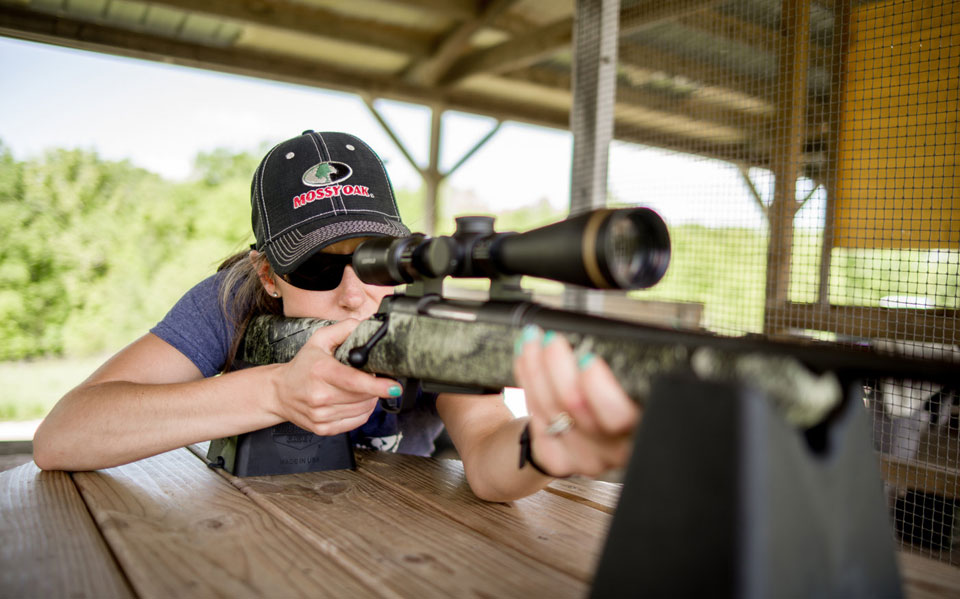
My daughter’s name is Eden. She’d taken her hunter safety course and was 12 years old when we went on our first deer hunt together. I’d bought her a .243, and we’d spent some time on the rifle range. She could shoot that gun better than I could. Eden became extremely confident in her ability to aim and shoot accurately. Our youth season here in North Dakota is only 10 days, which includes two weekends and the weekdays between those two weekends.
The first weekend of youth season that we went out hunting, we saw some does, but none were close enough for her to shoot. The second weekend we went out to a point where I always saw does crossing. The longest shot Eden might have to take was 150 yards, and she was very confident shooting at that distance. On the last weekend of the youth season, we knew the sun would go down about 7:30 p.m.
We saw several mule deer crossing in front of us, but Eden had a white-tailed doe tag and couldn’t take a shot. At last, the does crossed in front of us and walked out past us into the corn field. We both had on our Mossy Oak Bottomland camo and had our ThermaCells running due to the bugs being terrible. In a little while, we spotted three white-tailed does coming down the hill toward us on the opposite site of the valley we were watching. They went through a finger of woods. I told Eden to get ready for the shot. Eden put her cheek on her stock and sighted in on one of the does. I kept waiting for her to squeeze the trigger. I whispered, “Hold on the target, and use a slow trigger squeeze.”
Suddenly Eden picked up her head from the stock and announced, “I can’t shoot. I’m shaking so bad.” I told her to calm down and get ready. Eden waited about 30 seconds, took a deep breath, laid back down to shoot prone, got very still and took the gun off safety. I whispered, “Slow trigger squeeze,” and Eden fired. That doe dropped like she was a rock. I ranged the deer at 127 yards.
When I looked at Eden, I was so excited, but when Eden looked up at me, she was crying. The first thought that went through my head was, “Oh, no, she’s sad because she killed an animal.” I asked, “Eden, are you okay?” She answered, “Huh, huh. I’m just so excited because I shot my first deer.”
That one moment became the greatest moment in my hunting career. I saw my child I’d taught to shoot a gun and get involved in the outdoors with excitement written all over her face when she took her first deer. No words could explain the feelings I had.
I became very interested in becoming a hunter-safety instructor after Eden took her first deer with her .243, and I saw her joy that was a result of her having taken a hunter safety course and getting her first deer. Whether it’s a child or an adult who’s never hunted and watching them go through the anticipation that goes along with that first hunt and taking an animal is for me one of the most exciting parts of hunting now. By teaching these courses, I also get a chance to instill in new hunters the role conservation plays in the future of wildlife. All that’s very worthwhile to me. I’ve always loved to be outdoors. By teaching hunter’s safety, I can take the passion I have for being outdoors and show new hunters what hunting’s all about, and what role hunters play in preserving and perpetuating the hunting heritage that we enjoy.














